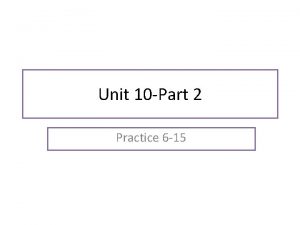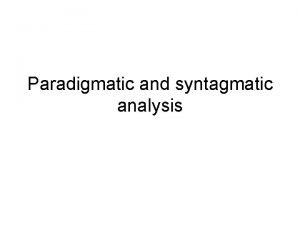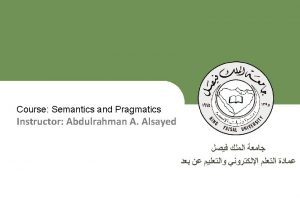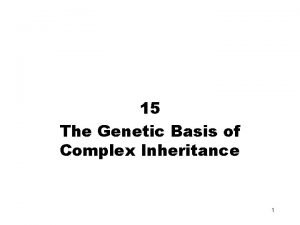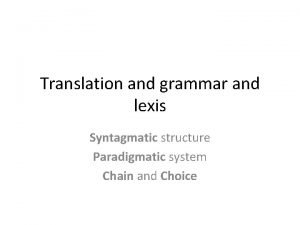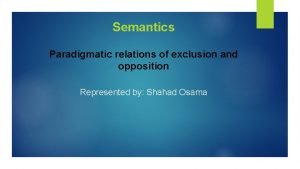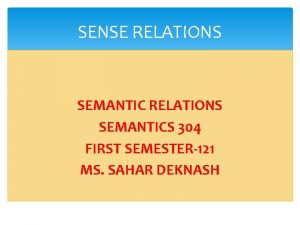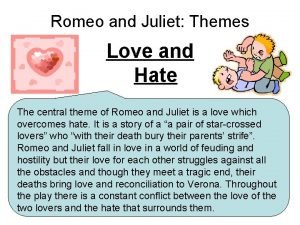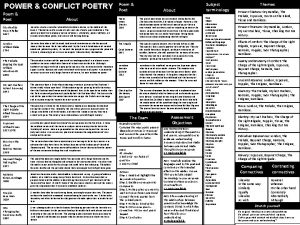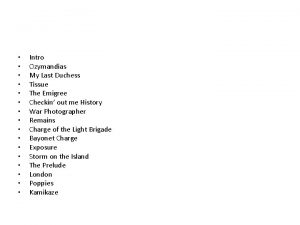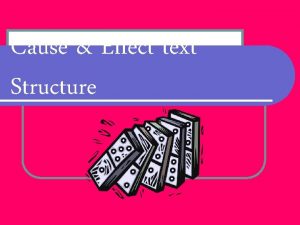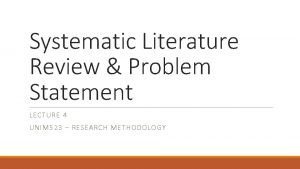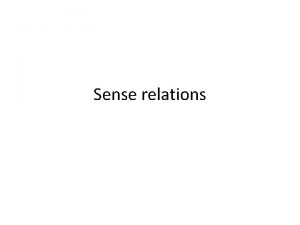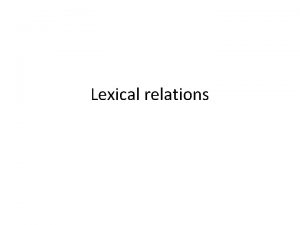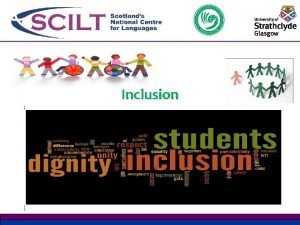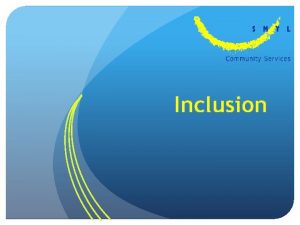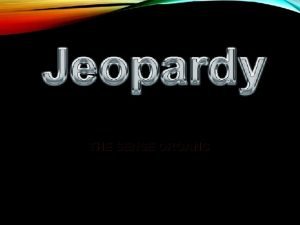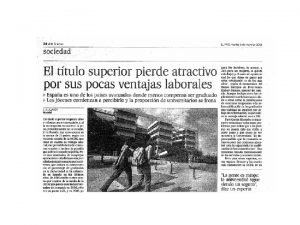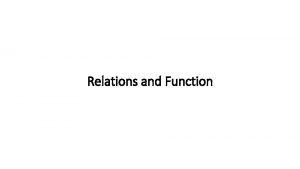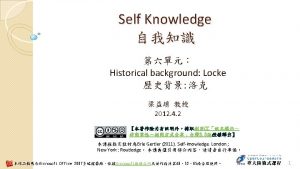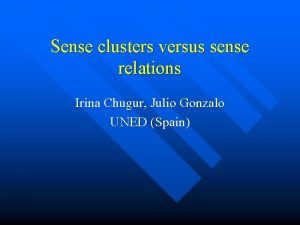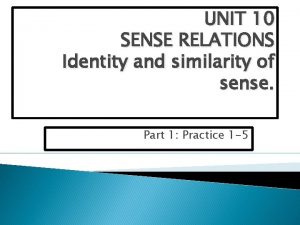PARADIGMATIC SENSE RELATIONS OF INCLUSION AND IDENTITY Presented

















- Slides: 17

PARADIGMATIC SENSE RELATIONS OF INCLUSION AND IDENTITY Presented by M. A. Student Rana Sameer Abdulrahman

The nature of sense relations • What makes a significant sense relation? • For example the relation between any two words chosen at random, say, dog and banana, and we can give this relation a name, say, dogbananonymy. • 1 - Recurrence: • The word banana + the word fruit = (more interesting relation) • The word dog + the word banana = (less interesting relation) • 2 - Discrimination: to be an interesting sense relation, we must not only include a significant number of lexical pairs, but also exclude a significant number. • The word dog + the word animal = (discriminating relation) • The word dog + the word banana = (is not a discriminating relation)

• 3 - Lexicalizability • The word dog + the word banana = (is not lexicalized relation and has not a verbal form) • The word dog+ the word animal= (A dog is a kind of animal) • 4 - Abstract vs. concrete relations: Sense relations may be relatively abstract or relatively concrete. • (X and Y) relation = dog: animal relation = unknown semantic area= an abstract semantic relation • (A and B) relation = (mare and stallion) relation = A and B refer to members of one species of animal = A refers to the female of the species, B refers to the male = a concrete semantic relation •

5 - Multiple simultaneous relations: For example, the pair true and false. The following relations hold between them: (i) True has a different meaning from false: (father: architect), red: green, long: short, as well as true: false. (ii) True and false cannot both be true when applied to the same proposition: red: blue, long: short, and true: false, but not (father: architect). (iii) True and false are opposites: long: short and true: false, but not red: blue (iv) True and false cannot both be false when applied to the same proposition: true: false but not long: short

What sort of entities do sense relations relate? Since there are units of sense with different levels of discreteness, ranging from homonyms, through polysemes, to facets, ways of seeing and subsenses, we use the possession of distinct sense relations as one of the diagnostic features for a unit of sense. Units of sense are contextually sensitive, so are sense relations. For example: Knife has the same, or a closely similar, relation to cutlery only in an appropriate contexts. But the same knife is not the appropriate tool in a surgical operation.

Varieties of sense relation 1 - Paradigmatic relations: which reflect the semantic choices at a particular structure point in a sentence. For example, I'll have a glass of — water lemonade Or involve words belonging to the same syntactic category , as in: They bought some — spoons cutlery. 2 - Syntagmatic relations: Syntagmatic relations hold between items which occur in the same sentence, particularly those which stand in an intimate syntactic relationship. For example: (1) The girl ran across the field ( is a normal sentence) (2) The girl sat across the field (is an odd sentence) (3) The smell ran across the field (is an odd sentence)

3 - Derivational sense relations : they are only accidentally found among words forming part of a set of paradigmatic choices, and only accidentally contribute to cohesion. They do, however, participate in one type of structuring of the vocabulary of a language, since they manifest themselves among items in what are called word families (i. e. words derived from a single root). i. cook(v. tr. ) Mary is cooking supper tonight ii. cook (v. intr. ) Can John cook? iii. cook (v. intr. The chicken is cooking) iv. cook(n. ) Lesley is a good cook v. cooker We've bought a new cooker vi. cooking (n. ) John's in love with Mary's cooking vii. Cookery John is taking cookery lessons.

Paradigmatic relations of identity and inclusion 1 - Hyponymy

• Some difficulties related to hyponymy: 1. It's a tulip ⊨It's a flower. It's not a tulip ⊭ It's not a flower. (may be it is carnation or daisy). 2. stallion: horse ≠knife: cutlery ( may be it is surgical knife). 3. Although hyponymy is a paradigmatic relation, it has syntagmatic consequences. Apples and other fruit ? fruit and other apples 4. The concept of hyponymy can be expressed in ordinary language as X is a type/kind/sort of Y A horse is a type of animal. ? A kitten is a sort of cat. (A kitten is a young cat). 5. Understood as a purely logical notion, hyponymy is a transitive relation: if A is a hyponym of B, and B a hyponym of C, then A is necessarily a hyponym of C (A = spaniel, B = dog, C = animal), but A car-seat is a type of seat. A seat is a type of furniture. *A car-seat is a type of furniture.

2 - Meronymy: Meronym Part-whole relation hand: finger (meronym or partonym) (Meronymy shows parallels with hyponymy), But with some exceptions Has logical properties with locative predication, e. g the wasp is on the steering – wheel ⊭ the wasp is on the car, but in the car Characterized by diagnostic frames, a finger is a part of a hand has fingers ? a hand is part of a finger ? a finger has palms

Features of meronymy: 1. Necessity Necessary parts, fingers Optional parts, beard 2. integrality Normal, Handle of the door Odd, Handle of the spoon 3. Discreteness Moves independently, Moving arm Less clearly separated, Tip of the tongue 4. Motivation Identifiable function Handle of the door Especial functional importance , tip of the tongue

5. Congruence: Range Phase Supermeronym handle: knife|umbrella semi-meronym handle: door Phase discrepancy flour: bread Type segmental parts Finger: hand Systemic parts nerve: nervous system

3. Synonymy There are three degrees of synonymy: a- Absolute synonymy: it refers to complete identity of meaning. Meaning is anything which affects the contextual normality of lexical items in grammatically well-formed sentential contexts. So, absolute synonyms can be defined as items which are equinormal in all contexts. For example, X, Y are absolute synonyms in any context ( X= Y= fully normal= slightly odd= totally anomalous). There is a difficulty in finding uncontroversial pairs of absolute synonyms : He is a big baby, is not he? (relatively more normal). He is a large baby, is not he? ( relatively less normal).

b. Propositional synonymy can be defined in terms of entailment. If two lexical items are propositional synonyms, they can be substituted in any expression with truth-conditional properties without effect on those properties. For example: John bought a violin (has one member of a pair of propositional synonyms)⊨ and entailed by John bought a fiddle ( has the other member of propositional synonyms) Differences in the meanings of propositional synonyms involve one or more aspects of non-propositional meaning : 1. differences in expressive meaning. ( John is professional, the fiddle is the neutral term). 2. differences of stylistic level (on the colloquial-formal dimension). ( John is outside the violinistic culture, the fiddle is more colloquial). 3. differences of presupposed field of discourse. ( shin: fibula; shin is in everyday term, fibula is used by medical specialists).

c. Near-synonymy The borderline between near-synonymy and non-synonymy is not obvious for two reasons: 1. The great majority of the pairs of words qualify neither as absolute nor as propositional synonyms. 2. It is not adequate to say simply that there is a scale of semantic distance, and that synonyms are words whose meanings are relatively close, but to say, that there is no simple correlation between semantic closeness and degree of synonymy. For example, the relation between dog and cat is that to signal a contrast; a major function of dog is to indicate "not cat/mouse/camel/(etc. While synonyms, do not function primarily to contrast with one another. In certain contexts, they may contrast, and this is especially true of near-synonyms: He was killed, but I can assure you he was not murdered.


References Cruse, D Alan. 2000. Meaning in Language. Oxford University Press. Great Britain
 Hyponymy
Hyponymy Inidb
Inidb Syntagmatic and paradigmatic analysis
Syntagmatic and paradigmatic analysis Syntagmatic and paradigmatic
Syntagmatic and paradigmatic Narrow sense heritability vs broad sense heritability
Narrow sense heritability vs broad sense heritability Narrow sense heritability vs broad sense heritability
Narrow sense heritability vs broad sense heritability Paradigmatic chain
Paradigmatic chain Reversives
Reversives Sense relation in semantics
Sense relation in semantics Collectivistic cultures
Collectivistic cultures Employee relations in public relations
Employee relations in public relations Maps identity
Maps identity Settings in dr jekyll and mr hyde
Settings in dr jekyll and mr hyde Romeo and juliet themes love
Romeo and juliet themes love How is power presented in ozymandias and london
How is power presented in ozymandias and london Ozymandias and london venn diagram
Ozymandias and london venn diagram Example cause and effect text
Example cause and effect text Problem statement for project
Problem statement for project
